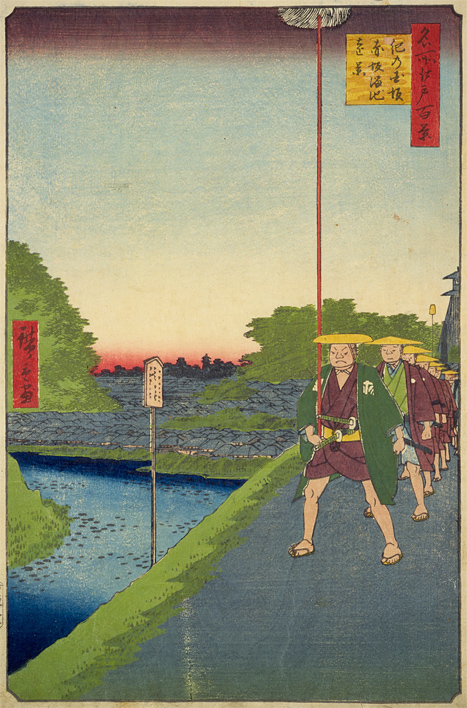. Famous Places and Powerspots of Edo 江戸の名所 .
::::::::::::::::::::::::::::::::::::::::::::::::::::::::::::::::::::::::::::::::::::::::::::::::::::::::::::::::::::::::::::::::::::::::::::::::::::::::::::::::::::::::::::::::::::
Tameike, 赤坂溜池町 Akasaka Tameike district
Akasaka tameike choo 赤坂溜池町 Akasaka Tameike district
Minato ward, Akasaka first to third sub-district
tameike 溜池 irrigation pond, "dammed pond", Akasaka Pool
This district does not exist any more.
The name "Tameike" is now only used for subway stations, road crossings and bus stops.
The original irrigation pond of the Edo period does not exist any more.
The pond used to be even bigger than the Shinobazu no Ike pond in Ueno.
Tameike is located on the Sanno Daichi 山王台地 plateau.
It was created in 1606 to provide drinking water for Edo.
Daimyo 浅野幸長 Asano Yoshinaga got the rights from Tokugawa Ieyasu to create this artificial lake and waterways.
It was a pleasant sight and with many lotus flowers in the pond in summer provided a great spot for relaxing.
- quote -
The nearby river was fashioned into a moat around Edo Castle, with some of it channeled into a pond used as a reservoir in present day Tameikesanno - Tameike meaning "dammed pond."
The ready water supply meant a cluster of eateries developed in Tameikesanno, and in the post-feudal Meiji era (i.e., from 1868) Tameikesanno became a pleasure quarter, with well over 100 geisha houses by the 1930s, frequented by nearby Nagatacho bigwigs, among others.
... the United States Embassy Tokyo is accessible from Tameike-Sanno subway station on the Ginza and Namboku lines.
- source : japanvisitor.com/tokyo... -

Tameike Sannoo, Tameike Sannō 溜池山王 Tameike-Sanno, Tameikesanno

The Tameike Sanno station is also located at
千代田区永田町二丁目 Chiyoda ward, Nagatacho 2chome.
..............................................................................................................................................

Edo Meisho Zue 江戸名所図会
溜池 Tame Ike, which was located in Akasaka, was an artificial lake
constructed in the foothills of Sannō by a daimyo called 浅野行長 Asano Yukinaga in 1606.
It was supposedly a very large lake stretching eastwards to
Toranomon, Shinbashi, and Shiodome, and westwards all the way to 赤坂御門 Akasaka Gomon.
At the time when the Kanda waterworks and the Tamagawa waterworks had not yet been constructed,
water sourced from this lake was used as supply water.
The lake began to be filled in from as early as the Jhō-ōh years (1652-1655),
and there were hastened works from around 1875, which drained the lake of its water
and turned it into tideland.
The works finished in 1910, and a narrow creek is now all that remains of Tame Ike.
- source : Tokoy Metropolitan Library -
.......................................................................

Sannoo Jinja, Sannō Jinja 山王神社 Tameike Sanno Shrine
. Sanno Gongen 山王権現 Sannō Gongen .
and Hiei Jinja 日枝神社 Tokyo // Sannoo matsuri 山王祭 Sanno festival
- Hie Shrine, also called 日吉神社 Hiyoshi Shrine.
..............................................................................................................................................

. Katsushika Hokusai . 葛飾北斎 (1760-1849)
Tootoo Aoigaoka no Taki 東都葵ケ岡の滝 Aoigaoka Waterfall in Edo
Now near 赤坂溜池 Akasaka Pool, Nagata Cho 永田町
During the Edo period, this was a kind of resort area for rich samurai to have a villa for summer.
.......................................................................

Kinokuni-zaka Akasaka Tameike enkei 紀の国坂赤坂溜池遠景
- Hiroshige 広重
. Akasaka 赤坂 "the red slope" district .
..............................................................................................................................................

- quote -
Asano Yoshinaga 浅野幸長 (1576 – 1613)
was a Japanese samurai and feudal lord of the late Sengoku and early Edo periods. His father served as one of the Go-Bugyō in the late Azuchi–Momoyama period.
- Career
Asano Yoshinaga was born at Odani, in the Asai district of Ōmi Province, in 1576, the eldest son of Asano Nagamasa, the adopted brother of O-Ne, Toyotomi Hideyoshi's wife. He married a daughter of Ikeda Tsuneoki.
His first action was at the Siege of Odawara, in 1590. In 1593, together with his father, he was granted Fuchu, in Kai Province. Though the Asano family was to be sent to Noto Province as a result of their implication in the alleged treason of Toyotomi Hidetsugu, the good offices of Maeda Toshiie kept them in Kai Province.
Yoshinaga achieved distinction together with his father in 1597, during the Siege of Ulsan, when they held the fortress under the command of Katō Kiyomasa. Though the Asano family was secure following its service under Tokugawa Ieyasu at the Battle of Sekigahara, it would be moved to Wakayama Domain, in Kii Province. The family would again be moved, to Hiroshima Domain, in the early 17th century.
Yoshinaga's three-dimensional battle standard, a gold-plated basketlike object, was well known during the Korean campaign. His daughters, Hanahime married Matsudaira Tadamasa and Haruhime (Haruhime was his daughter with Ikeda Tsuneoki’s daughter) married Tokugawa Yoshinao.
- source : wikipedia -
::::::::::::::::::::::::::::::::::::::::::::::::::::::::::::::::::::::::::::::::::::::::::::::::::::::::::::::::::::::::::::::::::::::::::::::::::::::::::::::::::::::::::::::::::::

- - - To join me on facebook, click the image !
:::::::::::::::::::::::::::::::::::::::::::::::::::::::::::::::::::::::::::::::::::::::::::::::::::::::::::::::::::::::::::::::::::::::::::::::::::::::::::::::::::::::::::::::::::::
. Minato ku 港区 Minato ward, "Harbour ward" .
. Akasaka Tamachi 赤坂田町 Tamachi district, "district of rice fields" .
. Edo bakufu 江戸幕府 The Edo Government .
. Famous Places and Powerspots of Edo 江戸の名所 .
. Doing Business in Edo - 商売 - Introduction .
. shokunin 職人 craftsman, craftsmen, artisan, Handwerker .
. senryu, senryū 川柳 Senryu poems in Edo .
. Japanese Architecture - The Japanese Home .
. Interior Design - The Japanese Home .
. Legends and Tales from Japan 伝説 - Introduction .
[ . BACK to DARUMA MUSEUM TOP . ]
[ . BACK to WORLDKIGO . TOP . ]
- - - - - #tameike #akasakatameike - - - -
::::::::::::::::::::::::::::::::::::::::::::::::::::::::::::::::::::::::::::::::::::::::::::::::::::::::::::::::::::::::::::::::::::::::::::::::::::::::::::::::::::::::::::::::::::







































